Excerpts from Jim Conrad's
Naturalist Newsletter
from the April 7, 2007 Newsletter issued from Sierra Gorda Biosphere Reserve, Querétaro, MÉXICO
WHAT IS A BURRO?
I saw so many burros during my hike to Bucareli that that question frequently came to mind. Specifically, what's the difference between a burro, a horse, a donkey, an ass and a mule? Earlier this week I'd seen a burro and her colt lounging beside the reservoir and I'd taken their picture. The picture is below:
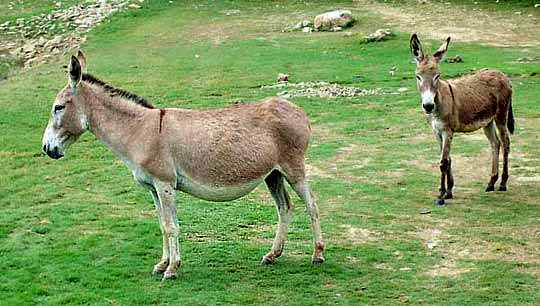
Unlike in the dog world, where all dog races belong to the same species (as proved by the fact that they can interbreed), horses and burros, though members of the same genus, are regarded as being completely different species.
"Asinus" in the burro's scientific name, suggesting a certain assiness to the burro, hints at a further truth. That is, burros, asses and even donkeys are pretty much the same thing. But, see the note below.
"Burro" is just the Spanish word for "donkey." I say "pretty much the same thing" because some people make a distinction between the descendants of donkeys introduced into the Americas by the Spanish in the 1500s, which they call burros, and donkeys introduced from Europe in modern times, which they call donkeys. Even people making a distinction between burros and donkeys appear to agree that both, being of the species "asinus," are asses. Jackasses are just "jack asses," or "male asses."
This brings us to mules. A male donkey or burro, called a jack, is crossed with a female horse to produce a mule. A male horse can be crossed with a female donkey (called a jennet or a jenny) to produce something that in North America is called a hinny, but in the United Kingdom is called a mare, or jenny, with the word jennet more commonly applied to the offspring of a female donkey and a male horse, regardless of whether the foal is female or male.
The diploid chromosome number of the horse is 64, while that of the burro is 62. This mismatch between chromosomes causes nearly all mules to be sterile.
Well, all this is gone into in much more detail at the American Donkey and Mule Society website at http://www.lovelongears.com/.
One last thing to say is that burros/donkeys/asses are originally African species evolved to thrive on arid, scrubby land, which is pretty much what they have here.
from the April 21, 2007 Newsletter issued from Sierra Gorda Biosphere Reserve, Querétaro, MÉXICO
BURRO RETICULATIONS
At Cocos I saw many mountain slopes looking like the one below:
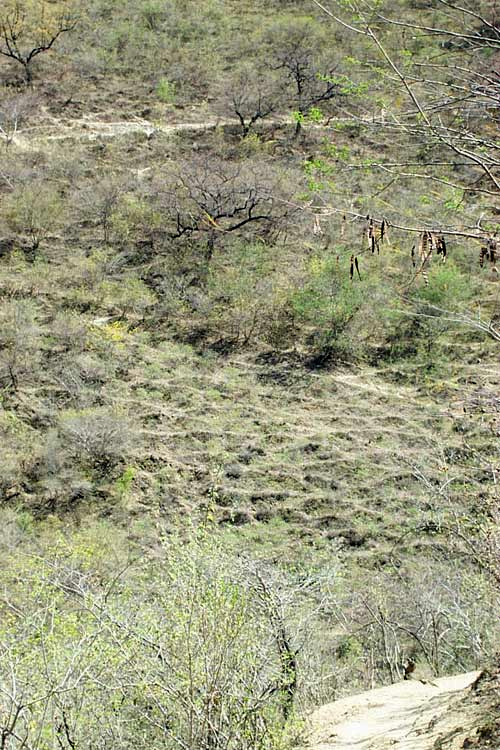
Notice the pale, reticulating network of footpaths ornamenting the slope. Those trails mostly were made by free-roaming burros and cattle. During my recent hike between Cuatro Palos and Bucareli, through a mountain landscape about as rugged and isolated as you can find, I was never out of sight of such footpath reticulations. No cattle were out there, just burros.
I suppose that a formula someplace can explain why free-roaming burros eventually impose upon a landscape intricate, geometrical footpath-patterns. A hiker on such a slope mainly thinks two things about such trails: On every square inch of the landscape they provide access to burros who nibble on everything that isn't spiny or bitter, and; two, too often the hiker ends up on a burro trail instead of the main trail.
The Sierra Club's position paper on "feral burros," at https://www.sierraclub.org/policy/wildlife/feral-animals states:
Like most normal people, I think burros are nice animals, smart, and fun to be around. But the above picture hints at the fact that's painfully obvious over enormous areas here: That humans have created a colossal ecological disaster by introducing burros into ecosystems where they don't belong, and killing off the predators that otherwise would control burro numbers.
I agree with the Sierra Club's position, not because it's an agreeable solution but because, like so often is the case (as with the war in Iraq), irresponsible human behavior has put people who come later into the position of being forced to choose the least bad
from the October 2, 2016 Newsletter issued from Rancho Regensis north of Valladolid, Yucatán, MÉXICO
BURRO DIGESTION
When I dump a wheelbarrow of pulled-up weeds for the three burrows to eat I'm always astonished by two things. First, the eagerness with which the burros trot up to eat the weeds, even if they've spent the morning grazing in the woods, and; second, the wholesale manner in which they gobble up the weeds, often taking in long "strings" of them, the leafy tops of one bunch entangling with the woody roots of another bunch, like eating long spaghetti. No effort seems to be made to separate the woody parts from the leafy. Even a species of Croton whose leaves burn my skin when I merely brush against it goes into the mouths without hesitation.
Among ruminants such as cows, sheep and deer, this kind of eating is understandable because ruminants have a pouch-like "rumen" at the base of their esophagus, where partly chewed food can be stored until the ruminant has the time to ruminate -- belch up some of the partly chewed food so it can be chewed much better. When the food is in better shape, it's swallowed again, but now it goes to the stomach where chemical digestion breaks it down further. But, burros as well as horses aren't ruminants -- don't have rumens.
Another part of the mystery is that in ruminants, hard-to-digest food like woody stems and roots collected in the rumen undergoes considerable "predigestion" by the process of fermentation, which is conducted by microbial action. With all the woody matter that burros eat, their digestion must be aided by microbial fermentation, too, but how do they do that without a rumen?
The answer is that the stomachs of burros and horses have a pouch called the cecum connected to the junction of the small and large intestines, and that's where fermentation of hard-to-digest food takes place. A burro's cecum is like a ruminant's rumen, except that it's at the end of the guts, not the beginning. This means that a burro can't burp up a "cud" to chew. In my experience, cows with rumens up front are good burpers, but burros with cecums in the back, are good farters.
Physiologically, the burro gut with its cecum accomplishes the same thing as a ruminant's gut with a rumen. Among ruminants, the stomach with its rumen makes up about 80% of the intestinal tract's capacity, with the colon or large intestine providing only about 13% of capacity. In burros, the stomach with no rumen offers only 14% capacity, while the cecum gives about 80%. This and other interesting info about burro digestion and food is freely available in PDF format at http://www.fao.org/livestock/agap/frg/lrrd/lrrd12/2/agan122.htm
In terms of feeding behavior, one way burros differ from horses is that the burro's muzzle is relatively narrower, though its lips are relatively larger and more manipulable. This means that the burro can be more selective about what goes into the mouth, even if it seems to be taking in everything indiscriminately. Take a look below at the burro Trotsky as he eats my weeds:
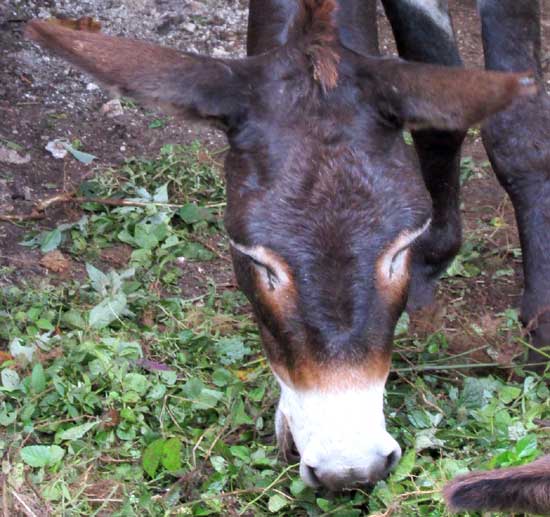
Notice how Trotsky's lips are actively managing the incoming food, even as his nostrils flair wide, enabling him to monitor the odors of what's being eaten.
Still, knowing all this, I continue to be amazed how such long, woody stems go into the burros. If the burros are biting and grinding the woody stems into small pieces before swallowing, then that explains it. However, I don't see the amount of chewing I think must be needed for such woody material. It would seem that a burro's cecum with its fermenting microbes must do an extraordinary job.
from the October 16, 2016 Newsletter issued from Rancho Regenesis near Ek Balam ruins in Yucatán, MÉXICO
MORE ON BURRO DIGESTION
Each day I continue to be struck by how the burros relish eating such large amounts of the weeds I pull up for them, weeds often with semiwoody or woody stems and roots.
Animals that eat a lot of such high cellulose food depend on bacteria living in their guts to ferment the cellulose. The fermentation breaks down the celluse into simpler compounds more easily digested and absorbed into the body.
The stomachs of many animals that eat high cellulose food have a bag-like extension on them called rumens. When hard-to-digest food is swallowed, it collects in the rumen and then later can be burped up and chewed again. Also, while incompletely chewed food resides in the rumen, fermentation takes place. Cattle are the best known "ruminants." Fermentation in the rumen is often referred to as foregut fermentation.
In contrast, the guts of burros, horses, as well as elephants, rhinoceroses and such small animals as rodents and rabbits lack rumens, but instead at the end of their guts their large intestines lead into a large "cecum," where fermentation takes place. The cecum isn't like a stuck-on bag, but rather a ballooning cylindrical extension of the large intestine. The cecum lies between the large intestine and the rectum. Fermentation in the cecum can be called hindgut fermentation.
At first glance, cow's foregut fermentation, with the cow's ability to re-chew its food at its convenience, and prepare food better before it enters the stomach, seems much more useful than a burro's hindgut operation. Is this a matter of ruminants such as cattle being more highly evolved than burros and horses?
Not necessarily. For one thing, the burro's hindgut fermentation, with no need to spend extra time re-chewing food, enables the burro to wander over large areas eating small amounts of low-quality forage all day long. Thus burros can survive in scrubby habitats where more sedentary ruminants, like cows with their foregut fermentation, need higher-quality food, such as that in grasslands and meadows, in order to get enough nutrition from the food in their relatively small feeding area. And scrubby environments are more commonly encountered than lush grasslands and meadows.
In fact, over the course of evolution animals of relatively large size have most benefited from hindgut fermentation simply because cecums tend to be bigger than rumens, and thus can hold more undigested food. The largest prehistoric herbivores, or "megaherbivores," such as elephants and indricotheres (types of rhinoceros), were hindgut fermenters. Sometimes the simple approach is also the most effective approach.
Not only certain kinds of mammals are hindgut fermenters with cecums, but also several insect types have them -- the best known being termites. Digestion of wood particles in certain termite species is accomplished inside microorganisms called gut flagellates, while on other species bacteria decompose the cellulose.
One reason the burros seem to like my pulled-up weeds more than anything else is that they definitely want a varied diet. If a wheelbarrow of freshly cut tree branches of a kind of tree they're known to like, such as those of the Bean-Family member Uaxim (Leucaena leucocephala, is dumped in their food bins, the burros will eat a little, then stop, even though I know they're still hungry. But if I arrive with a mixed selection of weeds, they'll run to eat them. Sometimes while they're eating the weeds, they'll swing around and take a few bites of Uaxim, proving that they have nothing against Uaxim, just that they want diversity.
Well, nutritionists tell us humans that a varied diet is best, and burros seem to know that intuitively.
from the March 18, 2018 Newsletter issued from Rancho Regenesis near Ek Balam ruins in Yucatán, MÉXICO
A BURRO IS BORN
Frieda the burro has been showing her condition for months, and now finally a healthy new burro has been born, shown below:
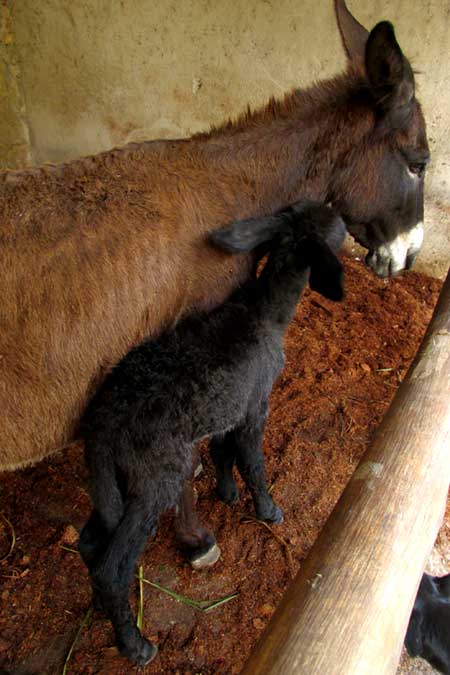
That picture was taken in early morning after the night in which she was born, so she's less than one day old. It's astonishing to think that such a large baby can issue from such a small burro. In the picture the newborn foal is trying to nurse below Frieda's head, though other times she manages to find a tit.
Even more amazing is what's shown below:
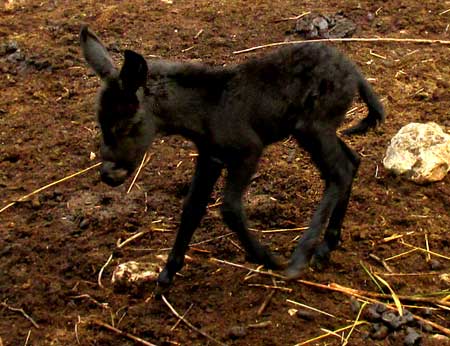
That picture was taken the next day and it shows the baby running from one side of the corral to the other, it's feet blurring. With each pass across the corral she would kick out her hind legs at least once. The impression was that she just couldn't hold in all her energy, and the kicks released some of it.
The running and kicking make sense, though. As a general rule, animals who are prey in the predator/pray equation, like burros, produce offspring capable of escape and defense very early in their lives. If a hyena were after her, kicking would be her main defense.
During the burro's first days everything fascinated her. At midday a rooster crowed, and her long ears instantly turned to hear it better. Walking by a big Zebu bull resting on the ground, tshe walked up and sniffed all around, the Zebu seeming to understand the moment's innocence. Below, the new burro at three days of age is shown at rest:
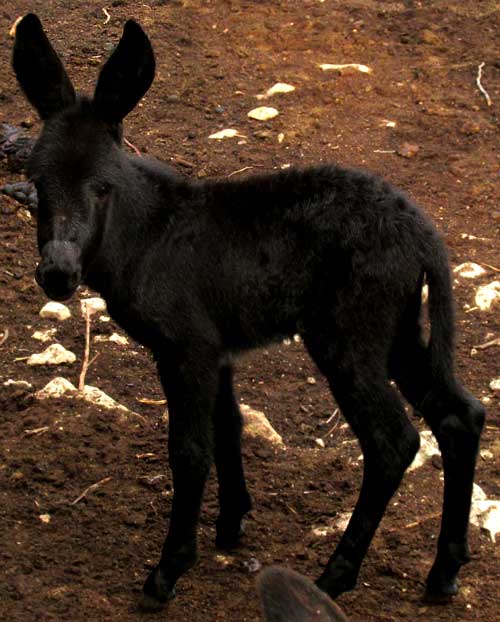
The fellows here tell me that all newborn burros are black, though the parents are brownish.